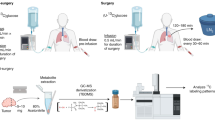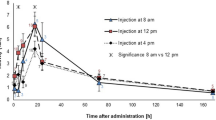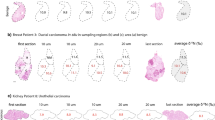Abstract
HUGHES et al.1 have shown that the thymidine analogue 5-iodo-2′-deoxyuridine (IDU) given to Swiss mice 5–10 weeks old is incorporated primarily into the DNA of rapidly proliferating tissues such as intestinal epithelium and bone marrow ; the amount of label retained by the mouse as a whole decreases rapidly with time. This is as expected, since as mice mature the cell populations of their tissues approach steady-state conditions and, therefore, only those cells with a short life-span are proliferating rapidly enough to incorporate significant amounts of IDU. However, if IDU is given to infant or embryonic mice, where the cell populations of most tissues are rapidly increasing, a different labelling pattern is seen. This is illustrated in Fig. 1, where the retention of iodine-125 activity by the mouse as a whole is plotted against the time elapsed since administration (intraperitoneal) of 125IDU to: (a) a litter of eight mice five days old; (b) a litter of five mice fifty-five days old; (c) a litter of seven mice five-days old which had received 25 µmole of thymidine simultaneously with the IDU. The ordinate represents the average retention of iodine-125 by each individual mouse expressed as the percentage of the activity originally administered. The experimental procedures used to obtain these results have been described elsewhere1.
This is a preview of subscription content, access via your institution
Access options
Subscribe to this journal
Receive 51 print issues and online access
$199.00 per year
only $3.90 per issue
Buy this article
- Purchase on Springer Link
- Instant access to full article PDF
Prices may be subject to local taxes which are calculated during checkout
Similar content being viewed by others
References
Hughes, W. L., Commerford, S. L., Gitlin, D., Krueger, R. C., Schultze, B., Shah, V., and Reilly, P., Fed. Proc., 23, 640 (1964).
Løvtrup, S., Acta Biochim. Polonica, 9, 411 (1962).
Zamenhof, S., Reiner, B., De Giovanni, R., and Rich, K., J. Biol. Chem., 219, 165 (1956).
Pelc, S. R., J. Cell Biology, 22, 21 (1964).
Author information
Authors and Affiliations
Rights and permissions
About this article
Cite this article
COMMERFORD, S. Biological Stability of 5-lodo-2′-deoxyuridine labelled with Iodine-125 after its Incorporation into the Deoxyribonucleic Acid of the Mouse. Nature 206, 949–950 (1965). https://doi.org/10.1038/206949a0
Issue Date:
DOI: https://doi.org/10.1038/206949a0
This article is cited by
-
Short fluorodeoxyuridine exposure of different human glioblastoma lines induces high-level accumulation of S-phase cells that avidly incorporate 125I-iododeoxyuridine
European Journal of Nuclear Medicine and Molecular Imaging (2006)
-
Quantitative analysis of distribution and fate of human lung cancer emboli labeled with 125I-5-iodo-2?-deoxyuridine in nude mice
Surgery Today (1993)
-
Evaluation of radio- and chemotoxic effects of125I-UdR on tumour growth and host survival
Radiation and Environmental Biophysics (1985)
-
Increased rate of tumor cell death caused by polyamine synthesis inhibitors
Virchows Archiv B Cell Pathology Including Molecular Pathology (1984)
-
Natural cytotoxicity in lymphatic metastasis
Cancer Immunology Immunotherapy (1984)
Comments
By submitting a comment you agree to abide by our Terms and Community Guidelines. If you find something abusive or that does not comply with our terms or guidelines please flag it as inappropriate.



